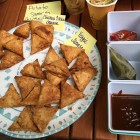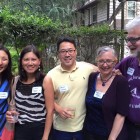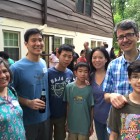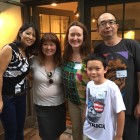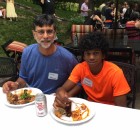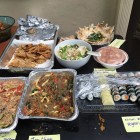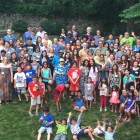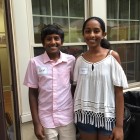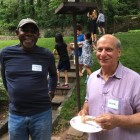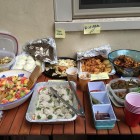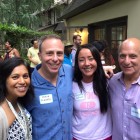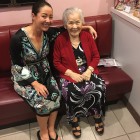This spring, a new Facebook group popped up for South Orange-Maplewood residents. But rather than using the community’s networks for connecting families to tutors and garage sales, the goal of this group, known as SOMAsian, is to connect community members who identify as Asian.
SOMA residents Vic Calle and Chris Stetson founded SOMAsian with a mission to “Bring out the Asians in South Orange and Maplewood.” The two started by organizing informal playdates with Asian-identified children. By Chinese New Year, the established group was holding a celebratory dinner at a local Thai restaurant. “We’re pretty flexible,” chuckled fellow member Andrew Lee. Lee had the idea to take the network online, and the community quickly grew from 29 households in February to an estimated 120 in May. Member use the group to have “pretty honest conversations about national politics, but also [about] where you get your hair cut,” said Lee. While it is still in the early stages, the founders eventually see the group as becoming part of a larger community discussion on race.
This past Saturday, South Orange Village President Sheena Collum hosted a community Asian-themed backyard potluck for SOMAsian members that drew more than 100 adults and children. Attendees shared their favorite Asian dishes, while mingling and getting to know one another.
Calle moved to South Orange 15 years ago and was impressed by the level of diversity, but did not make any effort to seek out fellow Asian community members until the birth seven years ago of her daughter, who is mixed-race. That is when the importance of knowing other Asian families became clear to her, said Calle.
“My mom and dad are very Asian and instilled in us the appreciation of our culture even though there weren’t that many Asians growing up [in Texas]. I think it’s important for any child to identify with their race, whatever race they are and whatever percentage of their race they are.” Calle’s mother and sister would eventually move into Calle’s home, but for her mother, who spoke only Mandarin, the move was entirely isolating. Later, she was able to meet another Chinese woman, which “changed everything, said the younger Ms. Calle. “This is life, and makes you feel part of the community.”
For some SOMA residents, raising Asian awareness has been a more challenging process. Columbia High School sophomores Sylvia Osner and Sydney Ha formed the Asian American Student Union (AASU) last fall with the mission of “confronting cultural misconceptions and stereotypes.” Ha remembers being chased from school with her mixed-Korean friend, with kids yelling racial slurs such as “ching and chong.” Juliet Savittieri (this reporter’s sister), who grew up in SOMA and is now in college, recounts being regularly called a “chink” and described as “oriental.” Savittieri believes it is a question of ignorance: “People think these are just other words for Asian.”
Osner and Ha said that despite setbacks – including some of their posters being destroyed and having to explain that the organization is not an anime club — the group has had considerable success. Since its founding, it has hosted two panels and organized trips to see Allegiance and to visit The Museum of Chinese America. The group advocates for all Asians, including Middle-Eastern and South Asian students, and welcomes allies of any background. Their ultimate goal is to incorporate more Asian-American history into the school curriculum. In history textbooks “there is one paragraph on railroads and one on internment camps,” Osner said. While waiting for national curriculum to catch up, AASU hopes CHS will offer a history elective focusing on Asian-American narratives in the coming years.
The presence of the AASU and SOMAsian are both signals of a growing Asian community in SOMA. In 2010, the US Census recorded 2,146 residents of Asian identification, 5% of the combined towns’ populations. This community includes Chinese, Japanese, Korean, Filipino, Indian, and Vietnamese residents as well as many more mixed-race individuals who until 2000 could only check one race on the census. While still small, the number shows that,“we are here,” said Lee.
In 2009, Board of Education member Madhu Pai became the first Asian elected official. Elected in 2015, Sheena Collum, a woman of mixed-Asian descent, currently serves as the Village President of South Orange. Collum does not consider her ethnicity as a motivation to serve because “[all residents] want a safe community, vibrant local economy, good quality schools. These issues cross over everybody.” She does find diversity important for questions of perspective, understanding that only a varied set of voices can express “what the community as a whole needs.”
Pai sees a clearer relation between her Hindu background and her education advocacy. As a parent, she facilitates presentations and holiday celebrations in SOMSD schools, to expose children to different cultures at an early age. Says Pai, “I know we like to pride ourselves on being a town that’s so diverse, but it’s not a very broad definition of diversity. It could be broader.” For Pai and the other members of SOMAsian, that definition means including ethnicity as well as race.
Lee and Calle both see the elections of these women as signs of progress in building a more inclusive community. Explains Lee, “we want to be a town which is known for being accepting, so more Asians feel like they can move here.” Calle believes that a greater presence of Asians in the community will motivate more Asian residents to make the leap from renting apartments to owning homes, a movement that will form a SOMA demographic that more realistically “reflects the reality of our social makeup.”
At this Saturday’s potluck, Lee prepared chicken adobo and Collum brought her grandma’s spicy tofu stew.

